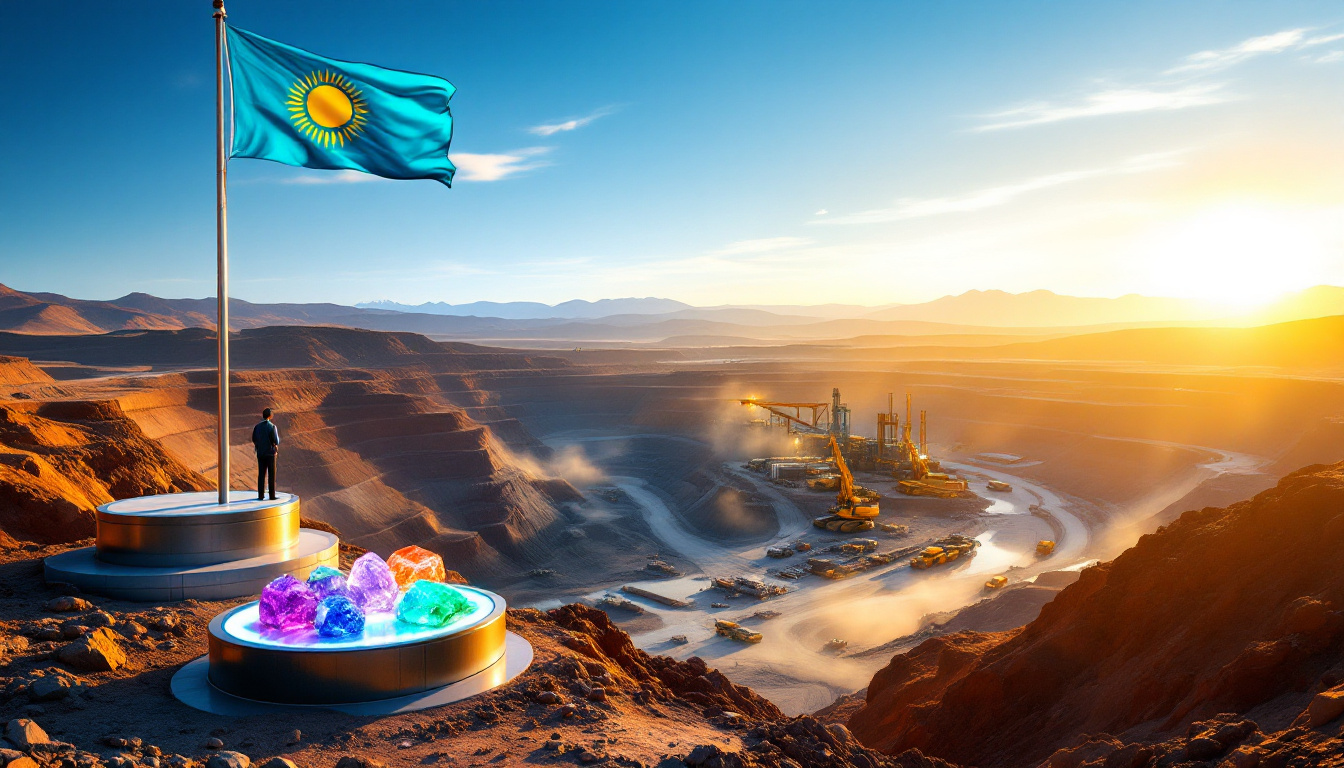US Investor Cameron's $5 Billion Offer for Kazakh Mining Giant ERG: Strategic Implications
Kazakhstan's mining sector is facing a pivotal moment as US investor James Cameron puts forward a substantial $5 billion offer to acquire Eurasian Resources Group (ERG), a deal that carries significant implications for global critical mineral supply chains and geopolitical relations.
What is Eurasian Resources Group (ERG) and Why is it Valuable?
Eurasian Resources Group, headquartered in Luxembourg, stands as one of the world's premier mining conglomerates with strategic assets spanning multiple continents. The company maintains a diversified production portfolio that includes copper, cobalt, aluminum, and iron ore – all critical materials for modern manufacturing and technology sectors.
The Kazakh government maintains a significant 40% ownership stake in ERG, highlighting the company's strategic importance to the national economy. This government involvement provides both stability and regulatory oversight that shapes the company's operations and potential ownership changes.
ERG's current valuation builds upon its history, including a pivotal 2013 private buyout that valued the company at $4.5 billion. That transaction transformed the formerly public enterprise into a private entity controlled by a consortium of investors alongside the Kazakh government.
The recent passing of Alexander Mashkevich, one of ERG's founding oligarchs, in March 2025 has created a transitional period in the company's ownership structure. His co-founder Patokh Chodiev now remains the sole surviving original principal stakeholder, with Mashkevich's approximately 20% ownership stake currently managed through his estate.
ERG's historical significance in critical mineral shortages production adds substantial value to the company's profile. Until 2012, ERG produced approximately 20% of the global gallium supply – a semiconductor material crucial for advanced electronics – before Chinese competition forced cessation of production.
Why is James Cameron Offering $5 Billion for ERG?
James Cameron's acquisition proposal values ERG at $5 billion, representing an 11% compound annual growth rate from the company's 2013 buyout valuation. This premium reflects Cameron's assessment of both current assets and future potential, particularly in the realm of critical minerals.
Negotiations between Cameron and ERG stakeholders have been ongoing since late 2024, indicating a carefully considered and methodical approach to the potential transaction. These discussions have included both the private shareholders and government representatives.
Cameron brings substantial mining sector experience to the table, having previously served as the board chairman of Petropavlovsk PLC from 2017 to 2020. During his tenure, he led a significant $1.2 billion debt restructuring initiative in 2019, pivoting the company toward higher-grade gold reserves before geopolitical tensions disrupted operations in Russia.
The proposed financing structure combines Cameron's personal capital with equity from a consortium of investors from the United States, Australia, and Middle Eastern nations. This diverse funding base reflects the strategic importance of the acquisition beyond merely financial considerations.
Goldman Sachs has taken a preliminary advisory role in structuring the potential transaction, lending institutional credibility and financial expertise to Cameron's bid. The investment bank's involvement suggests confidence in the deal's viability and alignment with broader global commodities insights and market trends toward securing critical mineral supply chains.
How Does Kazakhstan's Rare Earth Potential Factor into the Deal?
Kazakhstan's Emerging Role in Critical Minerals
Kazakhstan's mineral profile has gained significant attention following the recent discovery of a 20+ million metric ton rare earth deposit in 2025. This finding potentially positions the country as the third-largest holder of rare earth reserves globally, behind only China (44 million tons) and Brazil (22 million tons).
The Kazakh government has established ambitious targets to increase rare and rare earth metals output by 40% by 2028, demonstrating a national commitment to developing this strategic sector. This growth trajectory aligns with global demand increases for these materials in high-technology applications.
A pivotal factor in Kazakhstan's emerging minerals prominence has been the declassification of Soviet-era geological data. As Kazakhstan's Prime Minister Olzhas Bektenov noted, "Data on rare earth deposits, a state secret since Soviet times, is being gradually released to spur development." This information release has revealed substantial untapped reserves of neodymium and dysprosium – elements critical for electric vehicles and wind turbines.
Kazakhstan's strategic location between Europe and Asia positions it ideally to become a critical minerals supplier to multiple major markets. The country's "Middle Corridor" initiative, linking EU-Asian trade routes while reducing reliance on Russian and Chinese networks, further enhances this geographical advantage.
ERG's Strategic Position in Critical Minerals
ERG established a dedicated task force in 2024 specifically focused on rare earth exploration, with particular emphasis on promising deposits in the Balkhash and Karaganda regions. This proactive approach demonstrates the company's commitment to expanding its critical minerals portfolio.
The company's historical production of gallium – once accounting for 20% of global supply – provides valuable institutional knowledge and operational experience in specialized mineral extraction and processing. This expertise could be rapidly redeployed as market conditions shift.
ERG ceased gallium production in 2012 primarily due to aggressive Chinese competition that made operations economically unviable. This historical context has gained renewed significance amid current China's export restrictions and supply chain vulnerabilities.
A source close to the Cameron transaction noted, "Cameron's interest aligns with Kazakhstan's rare earth ambitions, positioning ERG as a cornerstone of Western supply chain diversification." This strategic alignment suggests the acquisition is motivated by more than conventional mining economics.
What are the Geopolitical Implications of this Potential Acquisition?
The United States has demonstrated increasing interest in securing critical mineral supply chains outside China, as evidenced by the US Department of Energy's allocation of $600 million in 2024 for non-Chinese critical mineral projects. A senior US State Department official emphasized that "Securing alternative rare earth suppliers is vital for national security and green energy transitions."
China's export restrictions on gallium and other critical minerals, particularly the December 2023 ban on gallium exports to the US, have heightened concerns about supply chain vulnerabilities. These trade actions have accelerated Western efforts to develop alternative sources.
Kazakhstan's strategic position between major global powers – Russia, China, and the West – gives it significant geopolitical leverage in mineral resource development. The country has carefully balanced these relationships while gradually opening to increased Western investment in strategic sectors.
The Cameron bid represents a broader trend of US investor interest in Central Asian mining assets. This diversification of international stakeholders helps Kazakhstan reduce overdependence on any single foreign partner while maximizing technology transfer and capital inflows.
The acquisition would potentially shift 60% of ERG's ownership to Western-aligned investors, representing a significant reorientation of a major Kazakh strategic asset. This ownership change would have implications for mineral export patterns and processing technology deployment.
What Challenges Face the Proposed Acquisition?
Regulatory approvals from the Kazakh government represent the most significant hurdle for the transaction, particularly given Kazakhstan's requirement for governmental approval for foreign ownership exceeding 50% in strategic sectors. The national security implications of critical minerals production will factor heavily in this regulatory review.
Valuation considerations compared to the 2013 buyout must account for both operational improvements and strategic positioning in growth markets. While the 11% CAGR from 2013 to 2025 appears substantial, it must be evaluated against industry benchmarks and future growth potential.
The ownership transition following Mashkevich's death introduces additional complexity, as his estate's approximate 20% stake requires appropriate resolution. This transition period creates both uncertainty and opportunity for ownership restructuring.
Competition from other potential international investors, including major mining conglomerates like Rio Tinto (which has expressed interest in Kazakh uranium assets), may emerge to challenge Cameron's bid. Chinese state-owned enterprises may also consider counterbids given the strategic nature of ERG's operations.
The political stability of Kazakhstan itself represents another consideration for investors, particularly given the country's 2022 constitutional reforms and ongoing transition from long-term authoritarian rule. Foreign investors must evaluate governance risks alongside mineral potential.
FAQ: Key Questions About the ERG Acquisition Offer
Who is James Cameron and what is his mining background?
James Cameron established his mining sector credentials during his chairmanship of Petropavlovsk (2017-2020), where he navigated complex debt restructuring and production optimization challenges. His leadership during a period of significant operational transition demonstrated capabilities in mining finance and governance.
Cameron's investment track record in the mining sector shows a pattern of targeting undervalued assets with strategic potential beyond current production metrics. His approach typically involves bringing Western capital and governance models to operations in emerging markets.
What are rare earth elements and why are they strategically important?
Rare earth elements comprise 17 metallic elements essential for manufacturing high-technology products including electric vehicle motors, wind turbines, military systems, and smartphones. Despite their name, many rare earths are relatively abundant in Earth's crust, but economically viable concentrations are less common.
The strategic importance of rare earths stems from their irreplaceability in many critical applications – particularly permanent magnets used in defense systems and renewable energy infrastructure. Currently, 90% of global rare earth processing occurs in China, leaving US defense systems reliant on Chinese-sourced magnets.
The extreme concentration of processing capacity creates significant supply chain vulnerabilities that governments are increasingly working to address through diversification initiatives. ERG's potential role in this diversification represents a key strategic value proposition in the Cameron acquisition.
How might this acquisition affect global critical mineral markets?
A successful acquisition could accelerate the development of non-Chinese rare earth production, potentially reducing price volatility and supply uncertainty for Western manufacturers. The impact would be particularly significant for elements like neodymium and dysprosium used in high-performance magnets.
The deal would likely trigger increased Western investment in Kazakhstan's broader mining sector, potentially establishing the country as a preferred jurisdiction for critical minerals development outside China. This investment cascade effect could substantially alter global supply dynamics.
In comparison to other recent mining sector acquisitions, the ERG deal would be notable for its explicit focus on critical minerals supply chain security rather than conventional production economics. This strategic imperative could justify premium valuations compared to traditional metrics.
What is Kazakhstan's broader strategy for its mineral resources?
Kazakhstan's 2024 National Mineral Plan prioritizes partnerships with OECD nations while offering substantial tax incentives for companies establishing domestic processing infrastructure. This approach aims to capture more value domestically rather than merely exporting raw materials.
The government has initiated several international partnerships to attract technological expertise and capital, particularly for minerals requiring sophisticated extraction and processing. These collaborations focus on sustainability and environmental standards alongside production targets.
Kazakhstan maintains a careful balance between state control and foreign investment, using its 40% ERG stake as a model for strategic sectors. This approach allows international capital and expertise while maintaining government oversight of national resource development.
Conclusion and Future Outlook
The Cameron bid for ERG represents a potential inflection point in global critical minerals supply chains, potentially establishing Kazakhstan as a pivotal player in Western efforts to reduce dependence on Chinese sources. Success hinges on navigating complex regulatory frameworks and validating ERG's rare earth potential through exploration and development.
As negotiations proceed, industry observers should monitor US-Kazakh strategic agreements, ERG's exploration outcomes in the Balkhash and Karaganda regions, and potential competitive bids from other international players. The resolution of Mashkevich's estate will also significantly influence the transaction's trajectory.
Regardless of the specific outcome, the Cameron offer highlights Kazakhstan's emergence as a critical minerals powerhouse and signals intensifying competition for resources essential to both renewable energy transitions and national security objectives. Moreover, this potential acquisition represents a significant development within the ongoing commodity super-cycle and underscores the importance of developing geopolitical investor strategies in today's complex global marketplace.
Disclaimer: This article contains analysis and speculation regarding mining industry trends and potential acquisition outcomes. Readers should consult professional advisors before making investment decisions based on this information.
Ready to Capitalise on the Next Major Mineral Discovery?
Stay ahead of critical mineral investment opportunities with real-time alerts on significant ASX discoveries through Discovery Alert's proprietary Discovery IQ model, turning complex mining data into actionable insights. Explore why major discoveries like those discussed can generate substantial returns by visiting the Discovery Alert discoveries page and begin your 30-day free trial today.




